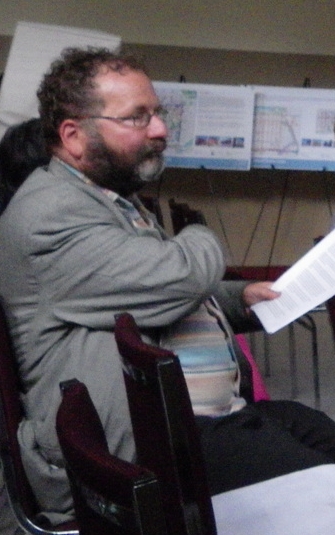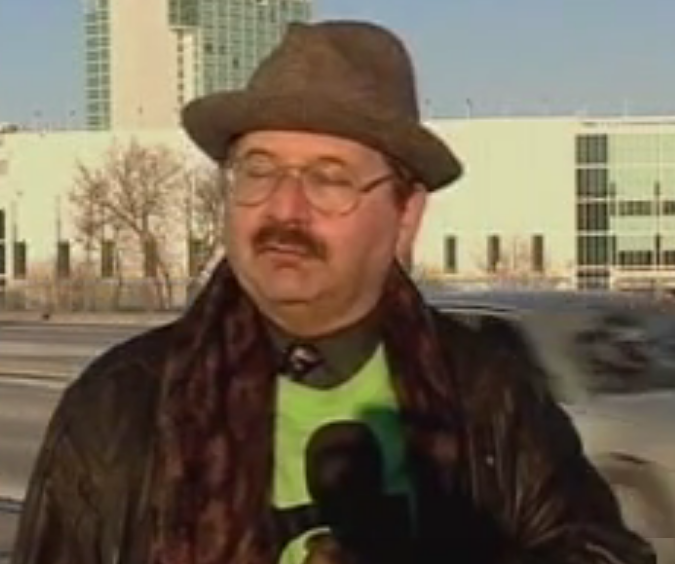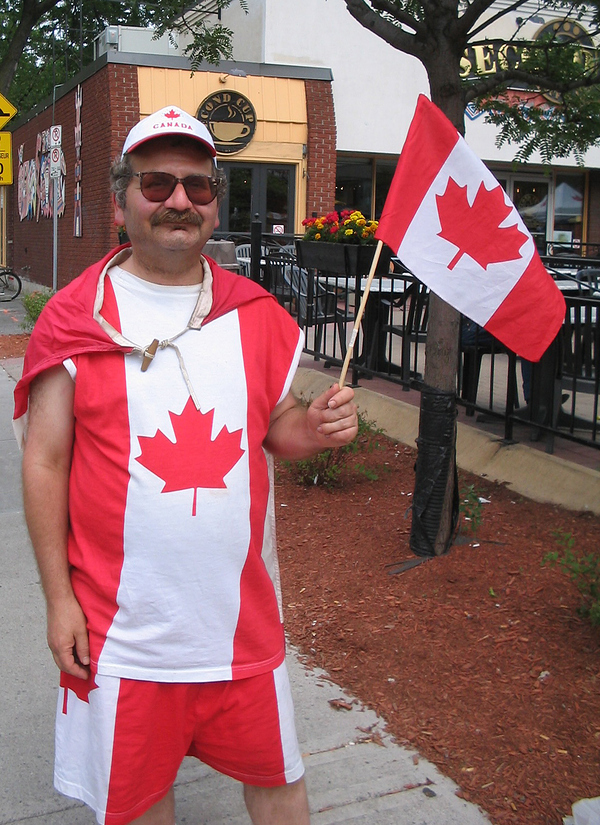
This is an expanded version of the article which ran in the August 2020 Centretown BUZZ.
Alayne McGregor
David Gladstone–a longtime civic activist, Centretown BUZZ journalist, and research scientist–died in early June. He had many passions, and the biggest was for his home neighbourhood of Centretown.
For decades, he was a familiar face around the neighbourhood: strolling down Elgin Street, organizing community meetings, making cogent presentations at city hall committees, capturing people and architecture with his camera, dancing to live music at local nightspots, or dressing up as Captain Canada on July 1.
“He was a wonderful blessing for the Centretown community,” said former City Councillor Diane Holmes. “For many years he was a real stalwart of planning in Centretown to maintain a residential neighbourhood this close to downtown and to maintain the health of the commercial streets.”
“He loved the community so much that he wanted to be out and about talking with as many people as he could about what was going on,” said BUZZ volunteer Archie Campbell. “Everybody knew him. He was like a good reporter who chats up everybody and listens to what they say and sometimes writes some of the stuff down.
“He was a forceful advocate. He was good at raising red flags for the community about what the important issues were, what people needed to mobilize about.”
Gladstone was one of the BUZZ‘s most consistent and prolific writers and photographers. In the paper’s first decade, he only missed one issue, and from 1999 onward, he had a monthly column. He’d summarize his work as chair of the planning committee for the Centretown Citizens Community Association (CCCA), talk about city transportation issues, and add “chatty exposition” of what he’d seen and heard in the last month.
The column was a big draw in the paper, Campbell said.
“He was always fairly acerbic,” founding BUZZ editor Robert Smythe said, “and would ascribe the worst intentions to people who brought forth bad developments. I pretty much published what he wrote. Sometimes he was a little intemperate and I would try to knock off the rough edges. And we tried to avoid libel.”
Gladstone always had issues of the BUZZ with him and would press them on anyone he met.
“He carried his files and hundreds of copies of the BUZZ in shopping bags. He was so unique that he was a billboard for the BUZZ, good or bad,” Smythe said.
His last column was in April, 2013; in 2015, he moved to Toronto for health reasons and to be nearer his family. His obituary said he died on June 4, and had been suffering from primary progressive Multiple Sclerosis.

Charles Akben-Marchand/THE BUZZ
Gladstone’s advocacy was like a part-time job for him, Holmes said. “He spent a lot of his time working with other members of the CCCA, and visiting the city, going to planning committee, and phoning and emailing comments in to planning committee members.”
From his home on Frank Street in the Golden Triangle, it was only a few blocks to Ottawa City Hall. It became his second home, said fellow light rail advocate David Jeanes: “he was always present for any kind of consultation at City Hall.”
Passionate and tenacious
“I have never met anyone who was as passionate about planning as him,” Smythe said. “He was always outraged when the city didn’t follow its own zoning and Official Plan policies and he was quite dogged in believing zoning was paramount, which I think is a very naïve thought these days. He was resolute.”
“He was tenacious.” said fellow City Centre Coalition member Ida Henderson. “He just wouldn’t give up. If there was a point he wanted to make, I’m quite sure he drove some people nuts sometimes trying to make it.
“He would bring something to whatever the issue was and he’d generally had a very good grasp of the issue. ‘I’ve got my five minutes; you’re going to listen to me.’ He would doggedly hold people to account.”
Gladstone was a master of city hall procedure, Henderson said–and that allowed him to spearhead a citizen takeover in 1998 of a city committee looking at the downstream effects of opening up on-ramps to the Airport Parkway. He wound up chairing the committee and “we basically controlled the agenda! They never let us do that again.”
A dream of light rail to Hull
Promoting transit and green transportation–and particularly light rail–was another passion.
In the 1990s, Gladstone was one of the authors of the Friends of the O-Train’s (FOTO) “Practical Plan” to bring surface light rail to downtown and to extend transit out to the suburbs along existing rail corridors.
He worked in the Louis St. Laurent Building in Gatineau, across from the Casino du Lac Leamy, and experienced the complicated transit connections to that area, Jeanes said. An existing rail line extends from Ottawa’s Bayview Station across the Prince of Wales Bridge to the Casino, and Gladstone never gave up the dream of creating a commuter rail service across that bridge.

[still from the video Use The Inter-city Rail Bridge.]
He was featured in a video promoting commuter rail between Ottawa and Gatineau by filmmaker Jim Blondeau (www.youtube.com/watch?v=-hxoA3IDGt8). He also successful pushed the National Capital Commission to undertake an interprovincial transit study.
“I was impressed with this little guy who seemed to be so fervent about his belief that we had to do more for public transit,” said FOTO member Tim Lane. “His basic premise was that we spend so much on roads and not anywhere near enough on transit and we’re not making use of the facilities that are already there.”
In 1994, FOTO volunteers including Gladstone ignored “No Trespassing” signs, and cleaned up the gravel pathway between the Bayview O-Train station and the Ottawa River Pathway, so it could be used by pedestrians and cyclists. This later became the northern end of the popular Trillium Pathway.
“We just did it!” said Jeanes. “We cleared out about 35 to 40 huge bags of garbage, and we put up metal signs down the pathway and at Bayview Station saying this way to the pathway. Councillor Holmes supported us and we did it under the Cleaning the Capital program. We even got a certificate for the clean-up job even though it was to a certain extent illegal. Whenever there was anything like that happening, David was there as one of the ringleaders.”

The music photographer
Gladstone knew Centretown’s nightlife as well as its politics. “He definitely did have a bit of bon vivant about him. David was known up and down Elgin Street. He knew all the pubs and restaurants and bars and nightclubs,” Henderson said.
He was close friends with Ottawa crooner and big band singer Johnny Vegas, and a regular at Vegas’ Wednesday night shows in the upstairs room at Maxwell’s.
“David was an avid supporter of local music,” Vegas said. “David and his trusty camera would show up to all sorts of different shows and take photographs and sometimes get up and dance. And of course like to have a pint or two.”
“I loved watching him dance. He had a really quirky little dance he’d do when he got excited. He would hop and bop a little bit and then he’d spin around. At Barrymore’s, his nickname was Spinner! Because when he really enjoyed a song he’d get up there and he’d be pogoing along and then he’d do these spins on the dance floor. He was quite infectious.”
Gladstone documented “so many gigs” at Ottawa music venues, Vegas said. “He started handing me photos. He would take a roll of film and then he’d go out and get double exposures made and he would hand a lot of the pictures to me. I still have a huge stack of unscanned photos from Dave. Eventually I just started calling him my official photographer.”
He liked all kinds of music, and supported local artists such as Kathleen Edwards. She “is very well-known now, but back then she was just a young struggling musician performing original songs, and David just loved her music. So we went to a lot of her shows. He had all these great photos of Kathleen Edwards performing at these little coffeehouses long before anyone knew who she was,” Vegas said.

A proud Canadian
Every July 1, Gladstone would dress up in a red and white Captain Canada outfit, Henderson said. “He was a very proud Canadian. He would wander Elgin Street in his outfit.”
Brilliant and analytical
Gladstone had two degrees in engineering, and worked as a civilian scientist at the Department of National Defence.
He used that same analytical intelligence as an activist: questioning assumptions, analyzing data, and looking for alternate solutions. Whether at meetings or in his monthly BUZZ column, he picked his words deliberately and pointedly.
“As a civil engineer, he had a lot of skepticism about the competence and advice that staff gave the city on planning and transportation issues,” Campbell said.
“I don’t think people appreciated his intellect. He would come up with zingers that would take me 45 seconds to figure out what he was saying, and then OK! I think he was a somewhat-lonely person.”
“He was really brilliant–a lot of people don’t realize that,” Vegas said. “It came across as quirky. At one point David made some copies of papers he had written for scientific magazines. One of them was the physics of how David slew Goliath!
“He knew all the physics. [At DND] his specific gig was to go and analyze munitions for frigates or for howitzer cannons that the Canadian Forces had.”
“He was easily exasperated by people that he didn’t respect,” Jeanes said. “He’d often express real consternation how somebody could be doing something so stupid, if there was something the city or consultants were proposing or doing that, from his point of view, didn’t make sense. He could easily show some frustration that way.
“But it never stopped him from his activism. He never gave up. He never walked away from a problem. And he was always writing about it in the BUZZ and making sure that people knew what was going on.”
BUZZ volunteer Patricia Marsden-Dole saw Gladstone shortly before he left for Toronto, sitting in the sun on Bank Street. “He reminded me philosophically that all good things come to an end.”
Do you have any memories of David Gladstone? Leave them in the comments below or email editor@centretownbuzz.ca .

3 comments for “David Gladstone was an activist and bon vivant who left his mark on Centretown”